continued from page more easily. ….
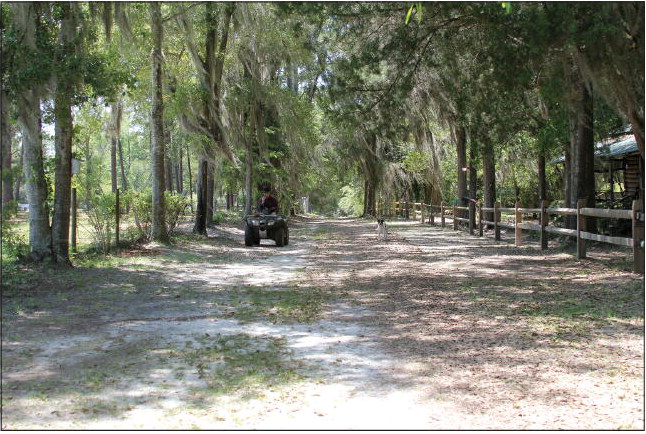

continued from page
more easily. The cemetery was also once kept free of grass as a sign of respect or those buried there, Angelo added. Growing Up During the Great Depression The old log house is truly a testament to time, and a tangible reminder of how families lived in the days when there was no electricity, running water, or motorized farm equipment. Rural farming families lived “off the grid” when doing so was not an adventure but a necessity.
Angelo vividly recalls those days. “My mother raised three boys alone during the Depression,” he said. When the Great Depression came, the Crowe family moved back to Wheeler County from Macon as jobs became scarce. It was about 1933, and Angelo’s maternal grandfather put a new roof on the old log house to make it more habitable; he also gave his daughter a cow, a sow, a rooster, and some hens to start a new life at the farm. The next few years proved to be particularly rough for the family. Angelo’s mother, Rosa, and father, Bartowe, eventually parted ways, and the youngest son, Conde Jan, died of leukemia in 1939.
Angelo recalls that during the Great Depression he and his two younger brothers were depended upon to pitch in with work at the farm. The chores began at dawn and ended after dusk. But Rosa valued education and going to school was a priority for her children.
Angelo remembers riding in a “hand-made” school bus built on a 1939 Chevrolet chasis driven by “Uncle” Willie B. Harrelson. Instead of having windows, the bus had canvas curtains on the sides that were rolled up or down, depending on the weather. “There were three benches inside the bus, one on each side and one in the middle,” Angelo said. While the customized vehicle was used for transporting students to and from school during the winter, in the summer it was repurposed to haul cotton and watermelons. “Back then, the state did not supply school buses. The Board of Education contracted with local citizens to build school buses,” Angelo said. This was accomplished by modifying the body of a flatbed truck with built-in sockets surrounding the edge of the bed where a “stake” was attached and changed out, according to the current need.
Angelo was kin to Uncle Willie B. on both sides of his family. Willie B.’s wife was Lula Mae, Crowe’s maternal grandmother’s sister, and she used to run the Sugar Creek Café in McRae. Willie B. was also Angelo’s maternal grandfather’s cousin.
After the Crowe brothers got home from school, they would make a beeline for the kitchen and grab a homemade biscuit and maybe a piece of ham or “fat back” (also called “streak of lean,” a cut of pork that is mostly fat) stored in the warming shelf of the wood-burning stove. The meat came from the family’s own smokehouse where hams and bacon from hogs butchered in the fall would be hung and cured. Sometimes, the boys would supplement their snack with something sweet. “Mother used to make the best fig preserves. We had five fig trees in our yard,” Angelo reminisced.
Angelo remembers working alongside his grandfather in the fields and pine forests. “I don’t know which I hated more, picking cotton or dipping tar.” The Crowe boys did their chores in the oppressive heat of summer days, while fighting off ants biting their bare feet or swatting the cursed South Georgia gnats.
After school, the Crowe boys changed their school clothes for work clothes, hooked up the mules, and started plowing or dipping turpentine. Armed with tar buckets, they would go from tree to tree, and using a special paddle, scrape out the turpentine tar from a cup attached to the tree and deposit it in their bucket. “I used to hate this. Every third or fourth cup, you better look out — black widow spider! We couldn’t afford gloves back then,” he explained. The deadly spiders often lurked behind the tar cups that were nailed to the pine trees.
During cotton picking time, the boys worked alongside other family members picking cotton by hand. Like dipping turpentine, it was hard, hot work. “The burrs on the cotton irritated your fingers,” Angelo recalled. Each picker had a croker sack and strap to pull along behind them as they worked the rows. The cotton was dumped from the bags onto a sheet on the ground. Each person had their own sheet which was tied up and weighed on a cotton scale in the field to determine how much they picked; then, the cotton was taken to the barn to be baled later on.
“We had to cut stove wood for cooking and fire wood for the fireplace to heat the house because there was no electricity,” Angelo said of his daily chores. When the temperatures dipped, the family went to bed covered up with layers of homemade quilts, and often, bricks or irons were heated by the fire and used to warm the bed.
Because they had no electricity, the family had an icebox — not a refrigerator— and this icebox was designed to hold a block of ice for keeping items like milk and butter cold. Ice was sourced from a traveling vendor. “Lois (called Loris) Grimes would come by twice a week with his ice truck and chip ice off of a 100 pound block of ice — 25 pounds for five cents or 50 pounds for 10 cents, and we would wrap it up in a croker sack and place it in our icebox,” Angelo said. He also remembers that the proprietors of Flanders’ “Rolling Store” from nearby Scotland came by routinely to sell their wares.
Like all farming families of the day, the Crowe family produced most of what they ate. Vegetables came from the garden, eggs were produced daily by the chickens, and fresh milk was always available if the milking was done each day. “In the morning, we milked the cows,” Angelo said of himself and his brother, Richard. The boys milked six cows each before school. “The worst part of milking was that the cows would flip their tails and hit you in the face,”hesaid. The boys didn’t have the luxury of a milking stool; they squatted next to the cow to do the milking, all the while blocking the cow’s calf’s attempts to compete for an udder. But one of the best things about early morning milking was coming in and having fresh milk for breakfast, Angelo said. Later, his mother would use “clabbered” milk to make biscuits. To clabber, the milk was left overnight to allow the cream come to the top. The cream was used to make butter, and the remaining “clabber” was used to make biscuits.
In those days, farmers allowed their cows to “open range” the land; crops were fenced in, but cows were allowed to wander about and graze during the day. Bells strapped to the cows’ necks made it easier to locate them when round up time came. “When the cows were let out in the morning, we watched them to see which way they headed. That made it easier to find them at the end of the day. The best time to round up the cows was at dusk,” Angelo said, demonstrating the call he and his brother used to bring the cows home and shut them up in the cow pen.
The Crowe brothers each had their own plows and mule for working the field on the family farm. Angelo’s mule was named “Old Red,” and Richard’s was called “Claude.” The boys worked after school and on Saturdays to plow a 50-acre field. The plowing began in December, and the field was ready to plant in April. “It was slow work,” Angelo said.
Right after World War II, the mules were retired and replaced by faster and more efficient motorized tractors; Ford 8-N and John Deere Tri-Wheel models were commonly used. He remembers that his grandfather bought a new tractor in 1947 for about $800, and it was not just used for plowing. With attachments, the tractor was multipurpose. It could cut wood, thrash peanuts, and a lot more. Now, Angelo treasures his collection of antique tractors, including an Ford 8-N and International Farm-all 100.
People were industrious in those days because every nickel counted. “Back during the Depression you didn’t throw away anything. You kept a sardine can to put your fish bait in,” Angelo said. “And where did you get your fish bait? You took a wooden stob and drove it into the ground at the edge of the water and rubbed the top of the stob with a smooth brick. The vibrations brought the worms up.” The technique was called “grunting worms” and it was a skill kids learned from their elders.
Lineage
Author and historian Hu Daughtry said the Harrelson family has been on the land where Angelo now lives since the land lotteries of the 1820s. In those days the site was located in Montgomery County. Wheeler County would not be created until 1912.
John William Harrelson I married Elizabeth Clark, daughter of Henry Morgan Clark, in 1826, and the couple appear on the 1830 census. John William’s father was Reuben Harrelson, who came to Georgia from Caswell County, North Carolina. Reuben’s father was Elkanah Harrelson, a Revolutionary patriot, who supported the Colonial cause and died at age 36. John William and Elizabeth had 13 children; five of their sons served with the Confederate Army and three — Pvt. Henry Hugh Harrelson, Pvt. Bradley Harrelson and Pvt. Elkanah Harrelson— are buried at the Harrelson Family Cemetery, along with their sister Aquilla’s husband, Pvt. Daniel Purvis. Two of the Harrelson sons, William and Reuben, died in Virginia while serving the Confederacy and are buried there.
Of the five Harrelson sons who went to war, Bradley, was the oldest, and was married and had a family when the war began. He fought with Company H, 47th Georgia Infantry Regiment and was wounded at a place near the Battle of Resaca in May of 1864. He came home on furlough and was home when war ended. He served as the postmaster at Eva, located at the Harrelson homestead, and died fairly young in 1885.
William Harrelson, who was also married and had a family as the war started, fought with Company G, 49th Georgia Infantry Regiment that was part of General Robert E. Lee’s Army of Northern Virginia. He and his brother Reuben, who was single, went to Laurens County to enlist. Both died of disease — Reuben of pneumonia on December13, 1862, and William three weeks later, likely of typhoid fever.
Henry Hugh Harrelson rode in the 4th Georgia Calvary which stayed in Southeast Georgia for most of the war. He enlisted after continued from page
he came of age in 1863 and lived until 1920.
The youngest of the five, Elkanah, who was born in 1847, enlisted in Company C , 7th Georgia Militia out of Montgomery County. “These boys gave a good accounting of themselves during the Atlanta campaign and in the Battle of Griswoldville where they took heavy casualties,” Daughtry said. Elkanah, who was named for his Revolutionary-era ancestor, survived the war, and died of pneumonia in 1900.
Daniel Purvis, another Confederate soldier buried in the Harrelson Family Cemetery, married Aquilla Harrelson, the oldest daughter of Elizabeth and John William Harrelson. He enlisted in Company E, 61st Georgia Infantry Regiment, known as the “Montgomery County Sharpshooters.” This regiment was part of the Lawton- Gordon-Evans Brigade, one of the most elite units in the Army of Northern Virginia.
Daniel was captured at Fisher’s Hill in September of 1864 and sent to the infamous prisoner of war camp at Elmira, New York. Called by those imprisoned there as “Hellmira,” the prison was known for its brutality. Daniel survived, but like many other Confederate veterans, was forced to walk all the way back home to Georgia. He lived until 1910, but Aquilla died in 1869.
In a May 20, 2023, ceremony, members of area Sons of Confederate Veterans (SCV) Camps raised the Confederate battle flag on a recently-erected flagpole and performed a rifle and cannon salute to honor the Confederate veterans.
John William Harrelson I died about 1855, and the exact location of his grave is unverified. He does not have a marker in the Harrelson Family Cemetery. His wife Elizabeth’s grave is prominently situated at the front of the Harrelson cemetery. Her epitaph reveres her as a member of the Methodist Episcopal Church South and the marker records her death date as 1891. Not far away is the grave of her servant, “Auntie Em,” who Angelo said his mother told him was the first person buried in the cemetery. Angelo erected a monument at the grave to ensure this information is perpetuated for future generations.
Angelo’s maternal grandfather was John William Harrelson II, known to all as “Uncle Champ,” whether they were kin or not. “Most people never knew his real name,” Angelo said. Champ was named for his ancestor John William Harrelson I.
Champ’s father and Angelo’s great-grandfather was Henry Hugh Harrelson, who inherited the log house and land from his mother, Elizabeth Clark Harrelson. Angelo can trace a straight line of ownership of the log house believed to have been built by John William Harrelson I to Henry Hugh Harrelson, to John William Harrelson II, to Rosa Crowe, to himself.
“Mother was born in a house a short distance from the log house on a tract of land that is still owned by the family,” Angelo said. That house also still stands. Angelo’s own parents married in 1926 after meeting in Macon where his mother attended Lanier High School for Girls and his father, who was from Commerce, worked as an industrial machinist. Angelo, the oldest of the four boys, is certain about the origins of his given names of John and Bartowe; he was named for his father and grandfather. As for the origin of his third given name, Angelo, the name he has been known by all of his life, it’s a mystery. “When I asked mother, she said ask dad and dad said ask mother. I theorized that I was named after some show business personality of the time.” The Harrelson Family Cemetery Walking through the Harrelson Family Cemetery offers an opportunity to connect with the past in a tangible way — to meet the pioneers who scratched out an existence on land only lately vacated by indigenous people in the early part of the nineteenth century. The names of the families recorded on the stones are predominantly Harrelson, but also resting in the cemetery are members of the Clark, Bellflower, Rainey, Ryals, Brack, and Horne families, among others.
It is an active cemetery with burials occurring often, and every year on the first week in May and on the first week in August, there is a gathering when descendants come together to spruce up the site.
Angelo can recall stories about almost everyone buried in the cemetery, and he knows how families are interrelated. “Everyone in the cemetery is kin except two,” he said. As he walks through the cemetery and stops by the graves, he shares his first-hand account of two brothers struggling over a gun that discharged and killed one of them… attending the funeral of a young woman driving a new convertible who was decapitated in a wreck in the 1930s…his own grandmother, “Dolly” Ruth Thomas Harrelson, who refused to buried in the same cemetery as her husband’s second wife, and is interred at Mount Olivet Methodist Churchyard nearby.
“I’m old enough to remember,” he said of all of the stories he knows. Recalling the night when the two brothers squabbled, he remembers hearing one of them calling for help from his home nearby. “I was sent for my grandfather. I had to walk to his grandfather’s house in the dark to tell him what happened. I still remember that walk. I was never so glad to see my grandfather’s house.” He was 13 at the time.
The cemetery is fronted by a polished stone and wrought iron entrance erected by Roscoe Coleman in honor of his mother, Pansy Harrelson Coleman, and his grandparents, Reuben Riley Harrelson and Winnie Kinchen Harrelson. Coleman also honored Rosa Harrelson Crowe, who at the time the entrance was erected, had devoted 60 years of her life to taking care of the cemetery. In reality, she would continue to do so for several more years until the end of her life.
An inscription on one of the stones at the entrance summarizes the sentiments associated with this sacred burial ground: The cemetery is land and trees, monuments and graves. A family is love, devotion, personalities and memories. One is physical, the other spiritual. The cemetery is respected. The family is loved.
A number of children’s graves near the front of the cemetery are marked with rocks and concrete but bear no inscriptions — a poignant reminder of the fragility of life and the high incidence of infant and child mortality in the days when doctors were scare and cures were unknown. Angelo wishes he had asked more questions about the little ones buried there, but theorizes that they may have died during an epidemic of diphtheria or some other highly contagious disease near the turn of the 20th century.
Ruth Burch Harrelson, Angelo’s maternal great-grandmother, is also buried near the cemetery entrance. Angelo recalls that when Ruth’s brick tomb began to cave in and had to be repaired, the workers got a look inside of it. “There was always a question about whether her coffin was above or below ground. It was above ground inside a tomb with a beautiful brick arch. Her husband, Henry Hugh Harrelson, (who survived her and built her tomb) was a brick mason,” Angelo said.
Rosa is also buried near the entrance of the cemetery that she faithfully tended for decades. She is surrounded by the graves of her sons, Conde Jan, Ray Alois, who passed away in 1986,and Richard, who passed away in 2019. A marker at the foot of her grave records the names of all of her children. She died in 2005 at age 98. Angelo Crowe’s Legacy
Angelo has been involved with the old family homeplace all of his life, even when he was busy building a career and raising a family in Atlanta. He visited his mother almost every weekend and brought along his children to help out with chores on the farm and to experience and appreciate country life. His mother was still living when he retired from the state Department of Education in 1993 and came back home permanently.
Angelo was baptized at Mount Olivet Methodist Church in Wheeler County when he was 12 and has always been a member there. He graduated from Wheeler County High School in 1945. “That year, the gym burned down and we had to graduate in the courthouse,” he remembers.
With his mother’s help, he received a scholarship to attend Berry College in Rome and vividly recalls catching a Greyhound bus in McRae to start his journey. “You had to be from a rural area to attend Berry College back then. You did not pay tuition, but all of the students had to work two days a week in lieu of tuition.” The 35,000-acre campus was self-sufficient. It had a dairy, farmland, canning factory, auto shop, bakery, laundry, even its own railroad station. Angelo’s occupation was working at the saw mill. He earned a bachelor’s degree in education, majoring in industrial arts.
When he left Berry College in 1950, Angelo thought he would farm with Richard, but his mother wasn’t going to allow her son’s hard-earned education to go unused. She laid the groundwork for Angelo’s long — and ground-breaking— career in education by nudging him toward his first job. Angelo laughs when he notes that he had three jobs after finishing college, but never filled out an application for any of them.
When Angelo graduated from Berry College, his mother was working for a man who had ties to the State Highway Board. “One day she said, ‘Get ready. You have to catch a bus on Monday,’ ” Angelo said. continued from page
Rosa had facilitated an arrangement that resulted in her son landing a position with the State Highway Department in the Highway Design Division in Atlanta. “I was surrounded by engineers and students from Georgia Tech,” Angelo said of his initial feelings of intimidation. He had been working for the State Highway Department only a short time when a former Berry College classmate told him about a job opening at North Fulton High School in Buckhead.
Angelo recalls he arrived unannounced in the office of North Fulton High, School Principal Warren T. Jackson. “We talked for 30 minutes and he asked how soon I could come to work.”
As Angelo taught industrial arts at North Fulton High another opportunity for career growth soon presented itself. When he was told that the school was considering instituting a driver education class, Angelo said he chuckled at the idea. He had been driving since he was 13 on the family farm, but he embraced the challenge.
In the pilot program, Ford Motor Company agreed to furnish the school with a specialized driver education car. “They were old clutch cars with dual controls,” Angelo said. The driver education curriculum was based on an AAA (American Automobile Association) text, and Angelo educated himself in workshops at Georgia Tech, the University of Georgia, in Wisconsin, Washington, D.C., and Utah, among other sites. “I enjoyed every minute of it!” he said of the experience.
It was the National Education Association (NEA) Traffic Safety Education Division that initiated driver education programs across the country, and Angelo started attending the organization’s annual meetings. “The State Department of Education did not have an office for driver education, but I found out that the National Insurance Institute for Highway Safety was offering a $5,000 scholarship to State Departments of Education for interns.” Angelo made a connection with a classmate from Berry College who was an official in the Secondary Education Division of the State Department of Education, and an intern was hired. By then, the federal Highway Traffic Safety Administration was established and money was available through that entity for driver education.
When he was approached about heading driver education for the state, Angelo struggled with leaving North Fulton High where he was involved in the Junior Civitan Club as an advisor. He had taught there for 22 years and he had met his wife, Latin teacher Nell Dahlberg, at the school. There were a lot of good memories at North Fulton High, but he took the state job and promptly set about lining up summer training for state educators who would be teaching driver education. The rest, as they say, is history. After setting up and running the state’s driver education program for 18 years, he retired in 1993.
Angelo and Nell were married for 20 years. After the couple divorced, Nell taught at the prestigious Westminster School in Buckhead. She now lives in Duluth with the couple’s youngest son, Martin.
Angelo has never been known for being idle. He still rises early and gets to work on the farm with his faithful dogs, Lola and Muffin, tagging along. He has been busy serving in various capacities in the community. Besides his work with the Pioneer Historical Society and the Sons of the Confederacy, he is active in his church and served as president of the Wheeler County Chamber of Commerce in 1999.
During his tenure in Atlanta, he served as President of the Northside Atlanta Jaycees (Junior Chamber of Commerce), as President of the Buckhead Civitan International Club, and as President of the National American Driver and Traffic Safety Association (NADTSA) in Washington, D.C. He organized the Southeast Region of NADTSA, which covers 13 southern states. He also started a Traffic Safety Club at North Fulton High School, and was active in the American Driver Education Association, and the Travelers’ Protective Association.
Angelo’s key to longevity is simple and straightforward. Aside from the great genes he inherited from his mother, he attributes his long and active life to clean living. “I grew up on a farm and learned how to do manual work. I do not imbibe in liquor or tobacco, and I try to eat a balanced diet, but I do lean a little toward sweets. I pray every morning when I get up and I don’t sleep late.”
His advice to young people who are beginning to find their way in the world is: “Take time to smell the roses, because later in life you will be sad if you didn’t. Ask your parents and grandparents about your family. I could just kick myself for not asking my mother more and recording it.”
With all he knows and has shared with others, and everything he has accomplished, one might wonder how he could have done more. But that is his outlook: there is always more to do and staying active is the best way to live a long and happy life.
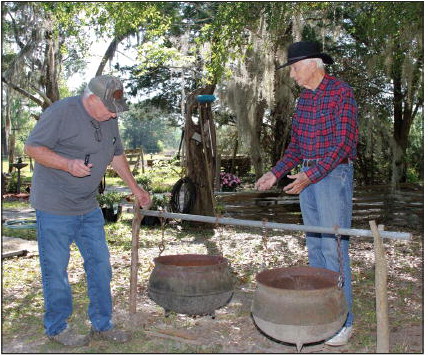
WASHPOTS—Angelo tells visitor Les Clark about the black cast iron wash pots he keeps on the farm for display and modern-day application. He likes to share that the pots were originally used for washing clothes and scalding hogs at butchering time. Now they are repurposed for boiling peanuts during social gatherings.
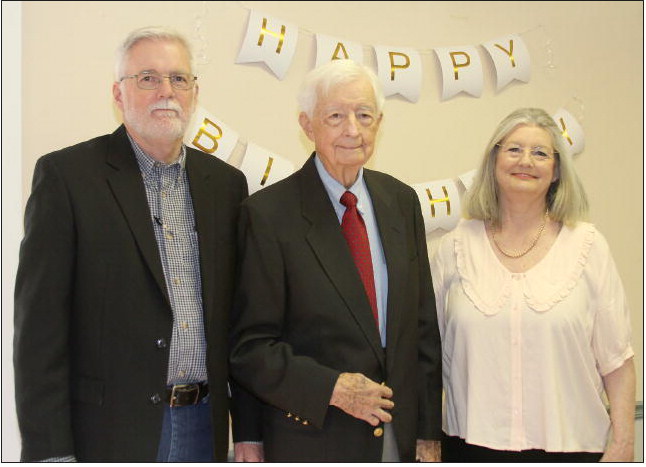
HAPPY BIRTHDAY — Angelo Crowe celebrated his 95th birthday with a party hosted by his son, Michael Crowe, left , and daughter Cathrine Keller, at Little Ocmulgee State Park on March 19, 2023.
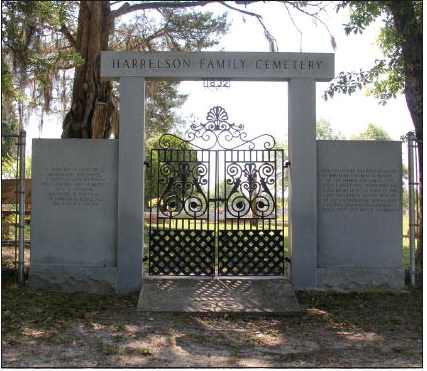
CEMETERY ENTRANCE — The elaborate polished stone and wrought iron entrance to the Harrelson Family Cemetery was erected by Roscoe Coleman in honor of his mother, Pansy Harrelson Coleman, and his grandparents, Reuben Riley Harrelson and Winnie Kinchen Harrelson. Coleman also honored Rosa Harrelson Crowe, who at the time the entrance was erected, had devoted 60 years of her life to taking care of the cemetery.
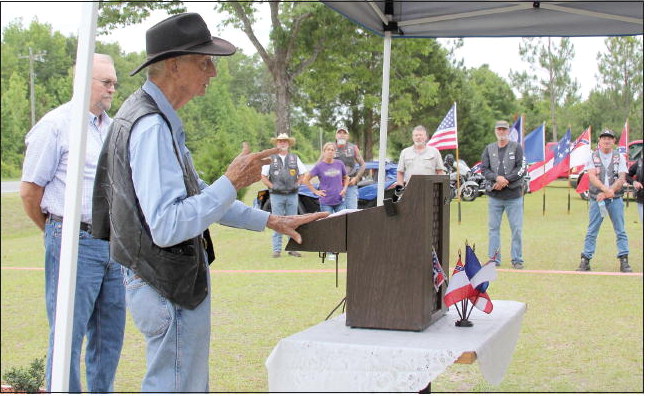
DESCENDANT SPEAKS — Descendant of Confederate Private Henry Hugh Harrelson, Angelo Crowe, speaks during a flagpole dedication ceremony in Wheeler County on May 20, 2023. Standing behind him is Georgia Division Adjutant Timothy Hawkins.








